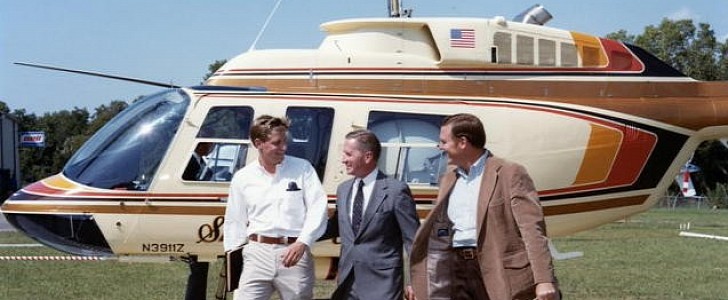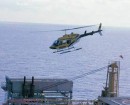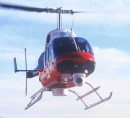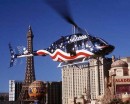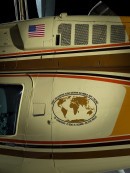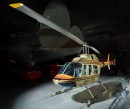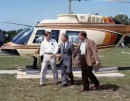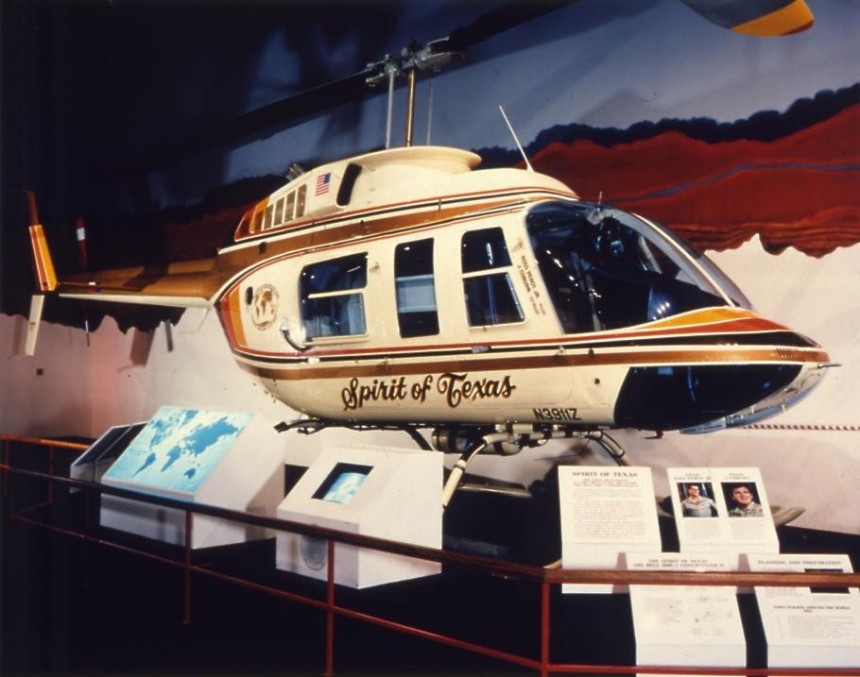Although eVTOLs (electric vertical takeoff and landing) are grabbing everyone’s attention when it comes to the future of vertical flight, let’s not forget that their “forefathers,” the conventional helicopters, are a recent development themselves. The first ones started flying in the 1940s, and it would take four more decades for a helicopter to be able to circumnavigate the world. The one that set this thrilling world record just hit a milestone.
This incredible journey would forever be remembered in the Guinness World Records as the First Circumnavigation by Helicopter, and would get H. Ross Perot, Jr. and Jay W. Coburn the FAA (Federal Aviation Administration) Gold Medal from the U.S. President at the time, Ronald Reagan.
Perot and Coburn were the bold pilots who completed the pioneering flight, successfully ending with a landing in Texas on September 30, 1982. The air vehicle that made it all possible was a Bell 206L LongRanger II, known as “Spirit of Texas.” Since Bell is now celebrating the 40th anniversary of this memorable achievement, it’s a great time to take a look at what happened back then.
In 1975, Bell kicked off production of the 206L LongRanger, a light helicopter described as the stretched version of the Bell 206B JetRanger. Just a few years later, in 1982, one of these rotorcraft would take to the sky with a very ambitious goal – to fly around the world, something that no helicopter had done before. At the time, only 43 years had passed since the first helicopter flight ever. Range and comfort were still far from what they can offer today, which made the project even more challenging.
The 42-foot-long (12.8 meters) 206L LongRanger, weighing 2,600 lb (1,179 kg) didn’t just take to the sky exactly as it was. First of all, it was stripped of everything that wasn’t necessary (“non-essential features”). Then, it was fitted with an additional fuel tank, a mandatory asset for such a long journey. It would end up making 56 refueling stops along the 29-day trip.
It was also prepared for potential water landing, with the help of some pop-out floats. Its bright, vibrant colors weren’t for show, but to make sure that other pilots could clearly spot it and avoid any mishaps. Last but not least, it was also equipped with the best navigation, communication, and safety systems available.
Powered by an Allison 250-C28B turbine engine, the Spirit of Texas took off from Dallas, Texas, close to its manufacturer’s headquarters. It would land in Texas after 29 days, three hours and eight minutes, having crossed 26 countries, and 22 oceans and seas. The world record was well-deserved – Spirit of Texas had covered 26,000 miles (41,843 km) in 246,5 hours of flight.
The victory wasn’t just about range, but also about speed. Not only was this the first world circumnavigation by helicopter, but it also broke the fastest point-to-point speed record. This was done on September 7, when Perot and Coburn hit 111.47 mph (179.3 kph) flew from London to Marseilles. For the rest of the trip, the average speed was 35.9 mph (56.9 kph).
One of the most remarkable moments of the historic flight was a landing onboard an American container ship. Because the Spirit of Texas couldn’t land on the Russian Kuril Islands, as it was supposed to, it had to do that onboard the S.S. President McKcinley instead, to refuel. Heavy winds and giant waves only made the unplanned landing in the North Pacific Ocean even more difficult.
Prior to that, the two pilots had flown to Canada, and to Europe. The Bell helicopter must have been a real sight when it landed at the Farnborough International Airshow, in the UK. After refueling in places like Naples and Athens, the helicopter crossed the Mediterranean to North Africa.
By the middle of the journey, it was making several stops in India, followed by Burma, and Japan. After the risky landing on the container ship, it would continue its trip to Dallas, with no incidents other than having to chase a bear off the runway. Unsurprisingly, that happened in Alaska.
We can only imagine the excitement of those who witnessed the record-breaking Spirit of Texas landing back in Dallas. Today, we can only admire this pioneer at the Steven V. Udvar-Hazy Center of the National Air and Space Museum, in Chantilly, Virginia.
As for the Bell 206L LongRanger series, it continued to operate. Its current version, the Bell 206L LongRanger IV, entered service in 1992, powered by a Rolls-Royce Allison 250-C30P engine with 415 kW of continuous power. It can seat up to seven people, and it’s equipped with Rockwell Collins Microline avionics.
According to Bell, its 206 and more recent 505 series of light, single-engine rotorcraft are still some of the most user-friendly platforms, and the 206L’s longevity seems to confirm it.
eVTOLs may be the new kids on the block, but they’ve still got a long way to go before achieving something as significant as Spirit of Texas’ historic flight.
Perot and Coburn were the bold pilots who completed the pioneering flight, successfully ending with a landing in Texas on September 30, 1982. The air vehicle that made it all possible was a Bell 206L LongRanger II, known as “Spirit of Texas.” Since Bell is now celebrating the 40th anniversary of this memorable achievement, it’s a great time to take a look at what happened back then.
In 1975, Bell kicked off production of the 206L LongRanger, a light helicopter described as the stretched version of the Bell 206B JetRanger. Just a few years later, in 1982, one of these rotorcraft would take to the sky with a very ambitious goal – to fly around the world, something that no helicopter had done before. At the time, only 43 years had passed since the first helicopter flight ever. Range and comfort were still far from what they can offer today, which made the project even more challenging.
The 42-foot-long (12.8 meters) 206L LongRanger, weighing 2,600 lb (1,179 kg) didn’t just take to the sky exactly as it was. First of all, it was stripped of everything that wasn’t necessary (“non-essential features”). Then, it was fitted with an additional fuel tank, a mandatory asset for such a long journey. It would end up making 56 refueling stops along the 29-day trip.
Powered by an Allison 250-C28B turbine engine, the Spirit of Texas took off from Dallas, Texas, close to its manufacturer’s headquarters. It would land in Texas after 29 days, three hours and eight minutes, having crossed 26 countries, and 22 oceans and seas. The world record was well-deserved – Spirit of Texas had covered 26,000 miles (41,843 km) in 246,5 hours of flight.
The victory wasn’t just about range, but also about speed. Not only was this the first world circumnavigation by helicopter, but it also broke the fastest point-to-point speed record. This was done on September 7, when Perot and Coburn hit 111.47 mph (179.3 kph) flew from London to Marseilles. For the rest of the trip, the average speed was 35.9 mph (56.9 kph).
One of the most remarkable moments of the historic flight was a landing onboard an American container ship. Because the Spirit of Texas couldn’t land on the Russian Kuril Islands, as it was supposed to, it had to do that onboard the S.S. President McKcinley instead, to refuel. Heavy winds and giant waves only made the unplanned landing in the North Pacific Ocean even more difficult.
By the middle of the journey, it was making several stops in India, followed by Burma, and Japan. After the risky landing on the container ship, it would continue its trip to Dallas, with no incidents other than having to chase a bear off the runway. Unsurprisingly, that happened in Alaska.
We can only imagine the excitement of those who witnessed the record-breaking Spirit of Texas landing back in Dallas. Today, we can only admire this pioneer at the Steven V. Udvar-Hazy Center of the National Air and Space Museum, in Chantilly, Virginia.
As for the Bell 206L LongRanger series, it continued to operate. Its current version, the Bell 206L LongRanger IV, entered service in 1992, powered by a Rolls-Royce Allison 250-C30P engine with 415 kW of continuous power. It can seat up to seven people, and it’s equipped with Rockwell Collins Microline avionics.
eVTOLs may be the new kids on the block, but they’ve still got a long way to go before achieving something as significant as Spirit of Texas’ historic flight.
